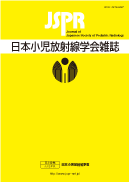Volume 36, Issue 2
Displaying 1-15 of 15 articles from this issue
- |<
- <
- 1
- >
- >|
Special Feature: Image inspection of child abuse
-
Article type: Image inspection of child abuse
2020Volume 36Issue 2 Pages 83
Published: 2020
Released on J-STAGE: December 26, 2020
Download PDF (485K) -
2020Volume 36Issue 2 Pages 84-90
Published: 2020
Released on J-STAGE: December 26, 2020
Download PDF (3320K) Full view HTML -
2020Volume 36Issue 2 Pages 91-100
Published: 2020
Released on J-STAGE: December 26, 2020
Download PDF (4148K) Full view HTML -
2020Volume 36Issue 2 Pages 101-108
Published: 2020
Released on J-STAGE: December 26, 2020
Download PDF (3549K) Full view HTML -
2020Volume 36Issue 2 Pages 109-114
Published: 2020
Released on J-STAGE: December 26, 2020
Download PDF (1055K) Full view HTML -
2020Volume 36Issue 2 Pages 115-122
Published: 2020
Released on J-STAGE: December 26, 2020
Download PDF (1325K) Full view HTML
Original Article
-
Article type: Original Article
2020Volume 36Issue 2 Pages 123-130
Published: 2020
Released on J-STAGE: December 26, 2020
Download PDF (2109K) Full view HTML
Case Report
-
Article type: Case Report
2020Volume 36Issue 2 Pages 131-136
Published: 2020
Released on J-STAGE: December 26, 2020
Download PDF (1498K) Full view HTML -
Article type: Case Report
2020Volume 36Issue 2 Pages 137-141
Published: 2020
Released on J-STAGE: December 26, 2020
Download PDF (1916K) Full view HTML -
Article type: Case Report
2020Volume 36Issue 2 Pages 142-146
Published: 2020
Released on J-STAGE: December 26, 2020
Download PDF (1355K) Full view HTML -
Article type: Case Report
2020Volume 36Issue 2 Pages 147-152
Published: 2020
Released on J-STAGE: December 26, 2020
Download PDF (1701K) Full view HTML -
Article type: Case Report
2020Volume 36Issue 2 Pages 153-158
Published: 2020
Released on J-STAGE: December 26, 2020
Download PDF (1641K) Full view HTML -
Article type: Case Report
2020Volume 36Issue 2 Pages 159-163
Published: 2020
Released on J-STAGE: December 26, 2020
Download PDF (1269K) Full view HTML -
Article type: Case Report
2020Volume 36Issue 2 Pages 164-169
Published: 2020
Released on J-STAGE: December 26, 2020
Download PDF (2296K) Full view HTML
-
2020Volume 36Issue 2 Pages 170
Published: 2020
Released on J-STAGE: December 26, 2020
Download PDF (464K)
- |<
- <
- 1
- >
- >|
